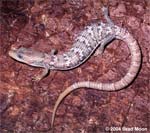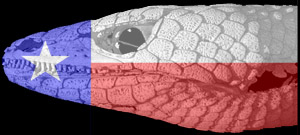 The Texas alligator lizard, Gerrhonotus infernalis, ranges from the Edwards Plateau region of central Texas west and south through central Mexico. It inhabits rocky hillsides, feeding on spiders, insects and small vertebrates. At 10-20 inches in length, G. infernalis is the largest species of Gerrhonotus, and one of the largest lizards to occur in Texas. Coloration varies from ruddy yellow to reddish brown with dark checkering on the dorsal surface, with a light gray ventral surface. Species of Gerrhonotus range from southwestern Canada to Panama, at elevations up to 11,000 feet. They are oviparous (egg-laying), with the timing and length of the breeding period varying with latitude and elevation. The Texas alligator lizard breeds throughout the year, and females exhibit brooding behavior. The Texas alligator lizard, Gerrhonotus infernalis, ranges from the Edwards Plateau region of central Texas west and south through central Mexico. It inhabits rocky hillsides, feeding on spiders, insects and small vertebrates. At 10-20 inches in length, G. infernalis is the largest species of Gerrhonotus, and one of the largest lizards to occur in Texas. Coloration varies from ruddy yellow to reddish brown with dark checkering on the dorsal surface, with a light gray ventral surface. Species of Gerrhonotus range from southwestern Canada to Panama, at elevations up to 11,000 feet. They are oviparous (egg-laying), with the timing and length of the breeding period varying with latitude and elevation. The Texas alligator lizard breeds throughout the year, and females exhibit brooding behavior.
Gerrhonotus infernalis is a member of Gerrhonotinae, a lineage within Anguidae. Anguids (see also Ophisaurus apodus) are also known as 'side-fold' lizards for the lateral fold that occurs along the body between the dorsal and ventral armor in some species. The armor consists of bones called osteoderms that are embedded in the skin, and this fold permits expansion for breathing and feeding. Fossils referable to Gerrhonotus are known from the Holocene of New Mexico, the Upper Pleistocene of California, the Lower Pliocene of Kansas, and the Upper Miocene of Nebraska.
Anguid lizards share several cranial features that can be seen in the CT imagery here. These include: posterior opening of vidian canal at basisphenoid-prootic suture (coronal slice 559); reduced supratemporal arch and narrowed supratemporal fenestra (horizontal slice 044); dentary forms dorsal and anterior border of anterior inferior alveolar foramen (sagittal cutaway view); retroarticular process deflected medially and broadened posteriorly (horizontal cutaway view); and tooth crowns striated on medial and, less often, lateral faces (Estes et al., 1988).

About the Species
This frozen specimen originated in the pet trade. It was made available to the University of Texas High-Resolution X-ray CT Facility for scanning by Dr. Jessie Maisano of The University of Texas and Dr. Jacques Gauthier of Yale University. Funding for scanning was provided by an NSF grant (DEB-0132227) to Dr. Jack Sites of Brigham Young University. Funding for image processing was provided by a National Science Foundation Digital Libraries Initiative grant to Dr. Timothy Rowe of The University of Texas at Austin.

About this Specimen
The specimen was scanned by Matthew Colbert on 13 March 2003 along the coronal axis for a total of 845 slices. Each slice is 0.043 mm thick, with an interslice spacing of 0.043 mm and a field of reconstruction of 20 mm. 
About the
Scan
Literature
Estes, R. 1983. The fossil record and early distribution of lizards, p. 365-398. In A. G. J. Rhodin and K. Miyata (eds.), Advances in Herpetology and Evolutionary Biology: Essays in Honor of Ernest E. Williams. Museum of Comparative Zoology, Harvard University, Cambridge, MA.
Estes, R., de Queiroz, K. and J. Gauthier. 1988. Phylogenetic relationships within Squamata, p.119-281. In R. Estes and G. Pregill (eds.), Phylogenetic Relationships of the Lizard Families: Essays Commemorating Charles L. Camp. Stanford University Press, Stanford, CA.
Links
Gerrhonotus infernalis page on the Herps of Texas site
Gerrhonotus care sheet by Melissa Kaplan
Anguidae page on the EMBL Reptile Database

Literature
& Links
Front page image.
|  |

Additional
Imagery
|

